Ugadi Pachadi (Ugadi Recipes 2025)
Updated: March 27, 2025, By Swasthi
Ugadi pachadi recipe – Ugadi recipes 2025. Happy Ugadi to all the readers and friends celebrating. Wishing a happy and prosperous year ahead 🙂 . This year Ugadi is celebrated on 30th March in India. It is a day celebrated to mark the beginning of New Year in Andhra and Karnataka. It is also celebrated in few other states. In this post, I have shared the recipe of ugadi pachadi along with a list of ugadi recipes you can make on this special day.
Ugadi pachadi is one of the most important ugadi recipes that is prepared on the day of ugadi and is offered to Gods seeking blessings for the year ahead. This is the first food we consume on the day of ugadi after offering it to god.
What is Ugadi Pachadi?
Ugadi pachadi is a mixture that has six different tastes sweet, sour,salt, pungent, spice and bitter. It signifies that life is a mixture of happiness, sadness, anger, disgust, fear and surprise.
- Sweet taste comes from jaggery & it symbolizes happiness.
- Astringent or pungent taste that comes from raw unripe green mangoes & it symbolizes surprises in life.
- Bitter taste that comes from neem flowers represent the sadness.
- Sour taste comes from the tamarind & symbolizes unpleasantness.
- Salty taste is from salt & represents fear of the unknown phase.
- Hot or Spice comes from pepper & symbolizes anger.
Ugadi pachadi is made of neem flowers, raw unripe green mango, jaggery, pepper powder, coconut and salt. There are slight variations of making this. Some of the other ingredients that are used for making this tastier are fried gram (putnalu pappu), cashews, raisins and sliced banana.
All the ingredients are approximations only including water in the ugadi pachadi recipe and can be adjusted to suit your taste.
Update: For years I had made ugadi pachadi using red chili powder instead of pepper powder. But recently I did watch a old video that was sent to me by a family member which talks about the traditional Naivedyam foods or foods offered to gods.
According to that source for ugadi pachadi, only pepper powder has to be used and not chilli powder. So I have updated the recipe. This may also vary according to family’s beliefs and customs.
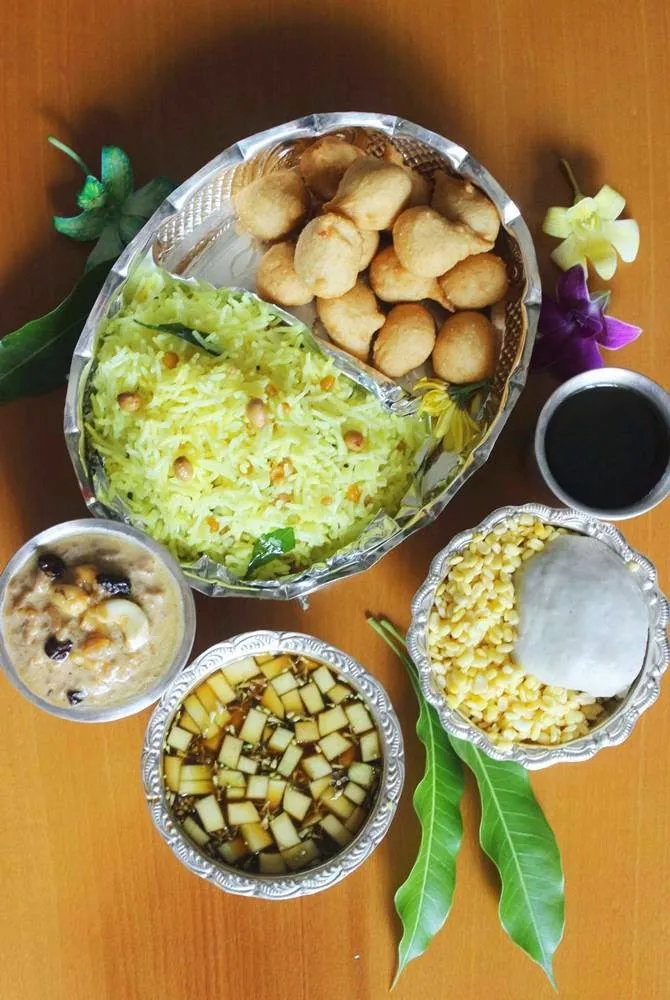
What can you make for Ugadi?
For ugadi, I usually prepare Garelu or minapapappu punugulu, pulihora, annam payasam, chalimidi, vadapappu and panakam. All these are made for pooja offerings.
For the evening snack time, I mostly make masala vada or make perugu garelu with the garelu I make in the morning. One day ahead I make either 7 cups burfi or mysore pak and some ladoo variety.
I have compiled some recipes for ugadi. Please scroll down to find them.
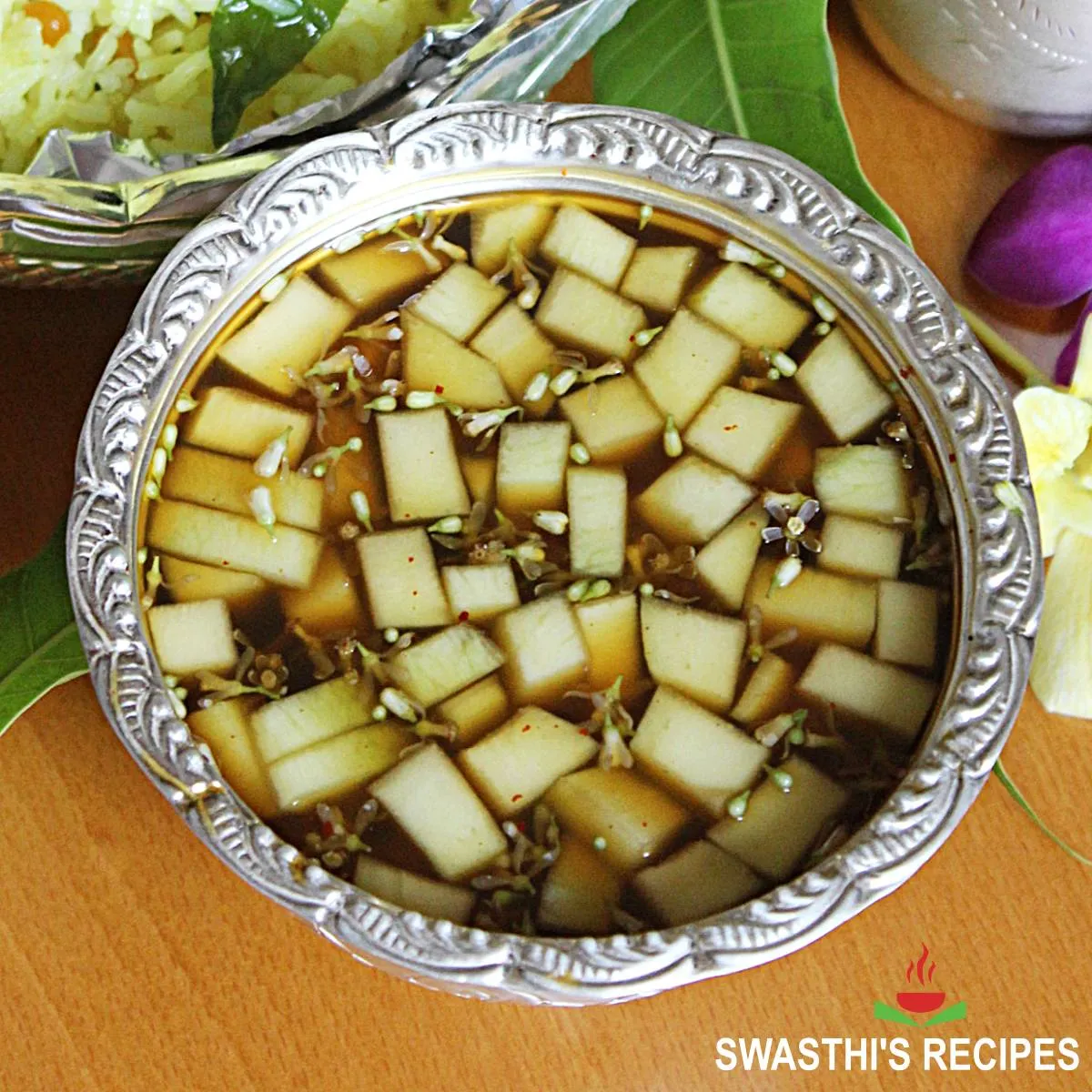
Recipe Card
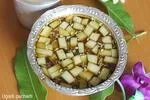
Ugadi Pachadi
For best results follow the step-by-step photos above the recipe card
Ingredients (US cup = 240ml )
- 1 ½ cup water
- 2 tbsp green unripe mango peeled and chopped, pieces
- 3 sprigs neem Few with flowers or 1 tbsp. flowers
- 1 pinch salt or as needed
- 3 tbsp Jaggery as needed
- 1 pinch pepper powder
- Tamarind as needed or 1 tsp tamarind pulp
optional
- banana ripe , Chunks
- Putnalu /fried gram
- Cashews chopped
- Raisins
Instructions
How to make Ugadi Pachadi
- Wash tamarind and soak it in ½ cup warm water till it softens.
- Traditionally only fresh neem flowers are used to make ugadi pachadi. But if you live in a place where you don’t get fresh flowers then use the dried ones.
- While the tamarind soaks, pluck the flowers from neem sprigs. Or alternate quick method: add the neem sprigs to a thin cloth, bring the edges of the cloth together so that they don’t fall off from the cloth.
- Hold the edges tightly and hit the cloth on to the kitchen counter several times. Neem flower or petals get separated from the sprigs and fall of in the cloth, collect them and set aside.
- Add grated jaggery to another one cup water, stir till it melts off. Filter it through a coffee strainer to another bowl, filter the tamarind pulp or water as well to the same bowl.
- Next add rest of the ingredients. Mix well.
- Do not taste it if you intend to offer it to god. Offer ugadi pachadi as naivedyam.
- Share ugadi pachadi with your family members & friends.
NUTRITION INFO (estimation only)
© Swasthi’s Recipes
Ugadi Recipes
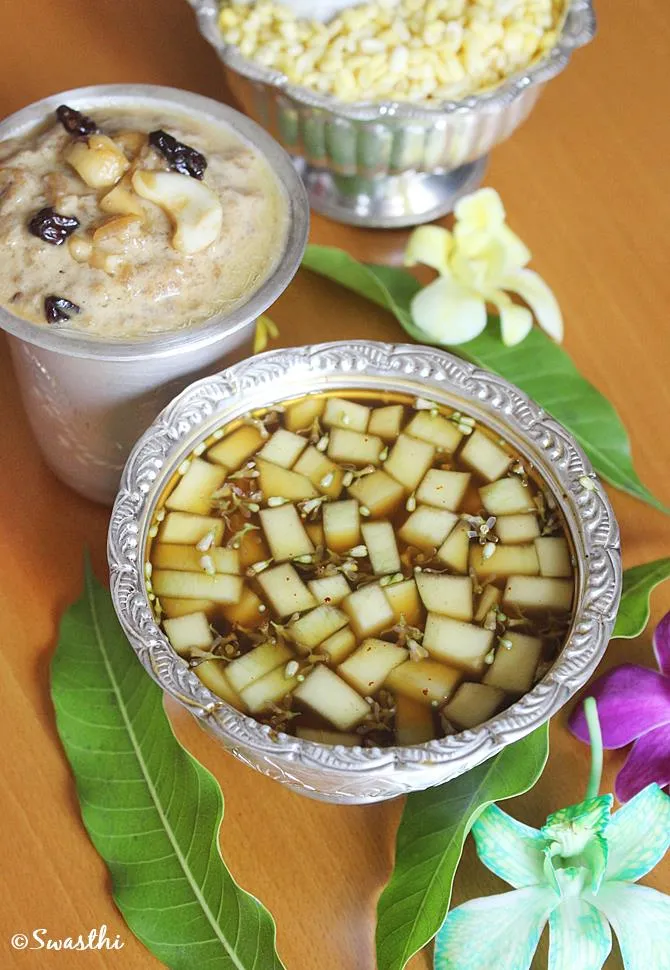
I have divided the ugadi recipes into 4 sections – Recipes for naivedyam, lunch, sweets recipes & snacks
Easy Recipes for naivedyam
Rice payasam is a delicious & traditional dish made with rice, milk, ghee, nuts & cardamom powder. This is a traditional Andhra style dish which we prepare during most festivals to offer as naivedyam. Traditionally the payasam is prepared with cow’s milk & ghee. Jaggery is used to sweeten the rice payasam. However if you prefer using sugar you can check this post on rice kheer.
Semiya payasam is another quick dessert prepared with vermicelli, milk, ghee, sugar or jaggery.
Sweet pongal is a dish made with rice, moong dal, jaggery, cardamoms, nuts & ghee. Making sweet Pongal is much easier than the rice payasam as there is no continuous stirring of the dish since there is no milk used here. So the cook time is also less.
Rava kesari is a dessert made with rava or semolina, ghee, nuts & sugar. This is a super quick recipe which can be made just under 25 mins. Rava kesari can also be made in many flavors like milk kesari, fruit kesari, pineapple kesari & mango kesari.
Urad dal bonda or minapa punugulu are quick alternate to vada or garelu. These are almost similar to the vada in taste only differ in the shape. These are super quick to make & are easy for those who have difficulty shaping the vada batter.
Panakam is a traditional drink made with jaggery, cardamom powder & water. I make panakam & chalimidi during ugadi, sri rama navami , vinayaka chavithi, Devi puja – dassara & Diwali. In some regions of Andhra Pradesh it is a tradition to offer this cooling drink to the deities.
Chalimidi & vada pappu are a combination of rice flour sweet with soaked moong lentils. We offer chalimidi & vada pappu always in combination with panakam as a tradition.
Recipes for advanced cooks
Paala thalikalu or thalikala payasam is a traditional dish made with handmade rice flour vermicelli, milk, jaggery, nuts & ghee. In this post I went ahead showing how to make the thalikalu with a murukku press. So it is simple enough even for a beginner.
Some people consider semiya as a processed food so avoid offering to the gods for naivedyam. They prefer these thalikalu as they are freshly made.
Poornam boorelu are sweet stuffed batter fried balls. The stuffing is made with chana dal and jaggery. I went the cut short way to make the outer coating with urad dal & rice instead of rice flour.
Medu vada or Garelu are a traditional deep fried snack made with black gram or urad dal. This post will help you to make the best fluffy & crisp vada at home using the mixer grinder. Just avoid using onions, chilies & ginger if offering to gods.
Ugadi recipes for lunch
Pulihora is a traditional Andhra style tamarind rice. This is prepared in most traditional households during festivals & is also offered to the gods. I have shared the recipe of we make at home.
Puliyogare is a Karnataka style tamarind rice which is made with fresh ground spice powder. It is completely different from the Andhra style. This is recipe will give you a very flavorful puliyogare.
Mango rice is another quick recipe you can make for ugadi lunch. Mangoes will be in full season during ugadi and most of us will have it. This is easy and quick to prepare. You can also make the mango mix and store it in a bottle for further use.
Curd rice is a simple dish made by mixing cooked rice with curd. Then it is tempered with spices & curry leaves.
Coconut rice is a tempered rice made with fresh coconut, peanuts, curry leaves, ginger & chilies. You can also make this coconut milk rice.
Bisi bele bath is a flavorful dish made with rice, lentils, spice powder & mixed veggies. This is a traditional dish which is prepared even on festive days.
Sambar rice is another similar recipe made with rice, dal, sambar powder & vegetables.
Ugadi recipes – Sweets
Here are some sweet recipes you can make for Ugadi. These can be made 1 to 2 days ahead of the festival.
Rava ladoo is one of the most commonly made ladoo variety from Andhra cuisine. These ladoos are made with rava (semolina), sugar, ghee & nuts. They are addictive, delicious & very flavorful. – 35 Ladoo recipes
Coconut ladoo is another popular sweet that is made in most south Indian homes. I have shared a traditional recipe using fresh coconut, sugar or jaggery, cardamom powder. If you make these ahead refrigerate them & use up within a week.
Boondi ladoo are sweet balls made with gram flour, sugar, ghee & elaichi. I have shared the recipe of tirupati ladoo in this post.
Kova ladoo also known as kova kajjikayalu are a popular traditional dessert made with mawa or khoya, coconut, jaggery & sugar. These are mawa balls with coconut stuffing.
Mysore pak is a royal dessert from mysore. It is a burfi variety made with gram flour, ghee & sugar. This detailed post will help you to make the best mysore pak at home.
Rava burfi is another burfi variety made with rava, sugar, gram flour & ghee.
7 cups burfi is a popular south Indian sweet made with 7 cups of ingredients. It is made with gram flour, coconut, nuts, ghee & sugar.
Coconut burfi can be made in 2 ways. I have shared both the recipes on this post.
Ugadi recipes – Snacks
Here are some popular snacks from Andhra & Karnataka cuisines. You can make snacks like murukkulu, nippattu & chekkalu 1 to 2 days ahead of the festival.
Punugulu is a deep fried snack usually made with left over idli dosa batter. However during festivals these can also be made with fresh batter or use the leftover garelu batter. If using garelu batter then add little rice flour.
Masala vada is are vada variety made with chana dal, spices, herbs & onions. These crisp fried vada can also be served as a side in a meal wiith coconut chutney. You can also check these mixed dal vada.
Mysore bonda are instant bondas made with maida or all-purpose flour. However I have made these with wheat flour, onions, chillies, coriander leaves & curd. These go very well with any chutney. For variations you can also check this aloo bonda .
Murukku or murukkulu are most commonly made in many telugu speaking households for every festival, especially if there are kids at home. Somehow my kids do not eat a lot of these so I make them only sometimes. You can also check these butter murukku & ribbon pakoda.
Nippattu, thattai & chekkalu are 3 different versions of the same crisp fried rice crackers. Each of these have a different texture & flavor.
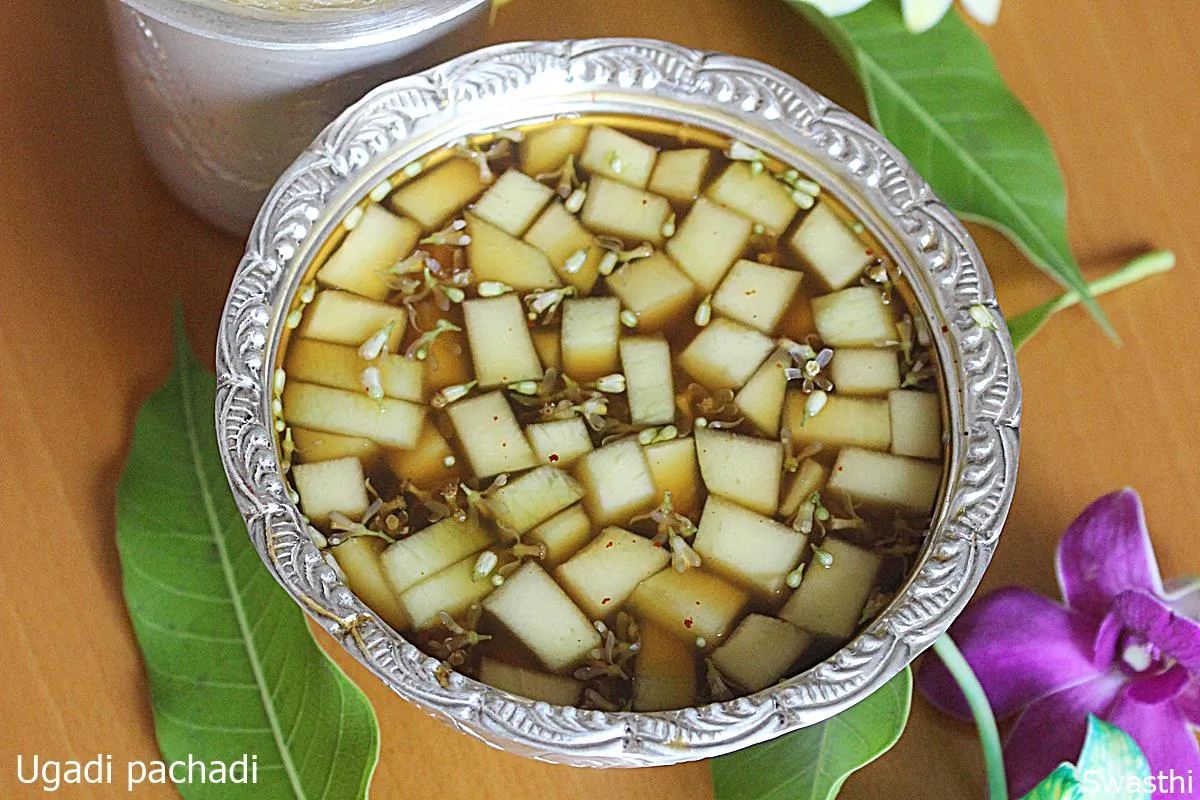
This post was first published in March 2014. Updated in March 2025.
About Swasthi
I’m Swasthi Shreekanth, the recipe developer, food photographer & food writer behind Swasthi’s Recipes. My aim is to help you cook great Indian food with my time-tested recipes. After 2 decades of experience in practical Indian cooking I started this blog to help people cook better & more often at home. Whether you are a novice or an experienced cook I am sure Swasthi’s Recipes will assist you to enhance your cooking skills. More about me
Follow Swasthi’s Recipes


Comments
Your ugadi pachadi looks perfect exactly like my mother’s. Going to make it for the first time this year.
Ugadi is celebrated with great enthusiasm and devotion especially in the states of Andhra Pradesh, Telangana and Karnataka. On the day of Ugadi, people wake up early in the morning and apply oil and take bath. Then they wear new clothes and decorate their houses with mango leaves and rangoli.
It is so amazing dish and tastful dish I love it
Very nice sir…very useful for me…nice to see your blogs sir
I come back to your recipe every year to make ugadi pachadi. Mango leaves, neem flowers and silverware all bring back childhood memories. This is how my family celebrates in India. Thank you for these recipes. Happy Ugadi Swasthi.
Thanks Sangavi. Wish you all too a very Happy Ugadi.
Swasthi Thank you for the Ugadi pachadi. I’m a newly wed and moved out to live with my husband. This year I will be trying your recipe. My mummy showed me this and told to follow the same. Thanks to chandrahas sir for telling us about the Telugu culture and Ugadi.
That’s great Varsha. Hope you enjoy! Wishing you both a Happy Ugadi.
Hi Swasthi,
Thank you for having the recipe here. Your update regarding pepper has caught my attention, and I would like to share my view regarding it. You see, chilies are not native to India. They, like tomato and potato, are from South America. Typically Gods and Goddesses are not offered foods that are not native to India – because they did not exist in India five hundred years ago and hence are not part of the ancient tradition.
Instances supporting this claim would be Ven Pongal – one of the longest surviving dish that uses pepper as its main ingredient. On the other hand, dishes like rasam, which typically have tomatoes, evolved only about two hundred years ago. Bengali cuisine that grew together with Bengali culture over the past four hundred years uses a lot of potatoes – there was no ancient tradition to be preserved here. About a few decades ago, potatoes would not be served in a traditional Telugu wedding. Now people are being more open to having all kinds of vegetables at a wedding feast because it is an occasion to celebrate. Yet, they still preserve the menu associated with death ceremonies as a sign of respect. Tuvar dal is never served in a death ceremony – only moong dal because Tuvar dal is not native to India. Maybe for this reason too, South Indians are reluctant to use masoor dal for daily use because they recognize that it is a recent entry into the Indian kitchen. Masoor dal came to India with Persians and made a fabulous entry into North Indian cuisines. It didn’t quite capture the fascination of South Indians despite its incredible cooking time!
Hi Chandrahas Sir,
I had always wondered why some temples do not use red chilli in any of the naivedyams like pulihora, curd rice etc. I never knew they were not native to India. Thank you so much for sharing all this. I didn’t know even about toor dal and masoor dal. Really enjoyed reading it. Thanks again.
Regards
Wow ? !!! What a lovely spread of dishes. Looks so mouthwatering and yummy ?. I have been following your blog for 2 years now. Every one at home loves my food. Thank you very much. Wishing you a happy ugadi.
Hi Neeraja,
Wish you all too a very Happy Ugadi. Thank you so much for following the blog.
🙂
Happy ugadi swasthi,, may God bless you always stay happy healthy nd blessed ?
Thanks a lot dear Mehak!!
Wish you all too a very happy Navratri.
🙂
hello plz subscribe me to ur mailing list to receive ur posts regularly in my email
Hi Sunitha,
I have added your mail id to the list. Please confirm the subscription when you receive the confirmation mail. Thank you!!
hello plz subscribe me to ur mailing list to receive ur posts regularly
Hi Sunitha,
Yes I will add your email to the list. Thanks for subscribing!
Hi Swasthi,
Wish you and your family a very happy ugadi.
Nice to see your posts with all the traditional snacks and sweets of Andhra. Most of these items aren’t available in the sweets shops in case if we are residing out of the state. Chalimidi is one of my favourite traditional sweet, I would really like to give it a try. Your blog has always been a saviour for me when it comes to cooking, so please do post the recipe.
Thank you so much.
Welcome Kavitha,
Thanks a ton for the wishes. Wishing you all too a Very Prosperous Ugadi. I have posted chalimidi recipe here. Thanks a lot for following the blog. Yes sure I will keep posting.
🙂
Good
Noru ooruthundi evanni choosthe
Thanks Sudhakar garu
Happy Ugadi Swathi….
Happy ugadi to you all too Anuanji
Thanks a ton
🙂
super awesome
happy ugadi swasthi enjoy and ur reciepies were too good it helped me a lot so a sweet thanks to u
Welcome Navyasree
Thanks for the wishes and for trying the recipes
Happy ugadi & new year
Thank you and wish you too a very Happy Ugadi
happy ugadi to u nd ur family swathi
Thanks a lot for the wishes
🙂
very delicious recipes swathi ur rocking
Thanks Manju
awesome recipes
Thank you
Happy Ugadi Swasthi and also to all others reading this. This recipe is sooo good and easy too. It came out very well.
Thanks a lot. God bless you.
Welcome Rohith,
Wish you too a very Happy Ugadi. Iam glad it turned out good.
Thank you so much
🙂